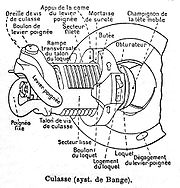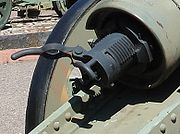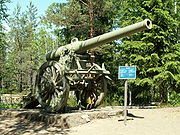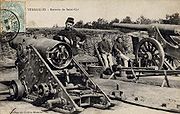
Charles Ragon de Bange
Encyclopedia
Charles Ragon de Bange often simply called de Bange, was a Polytechnician
and a French artillery
colonel of the 19th century. He invented the first effective obturator system for breech-loading artillery. Its basic principle of functioning is still widely in use to this day. He also designed a system of field guns of various calibers which served the French Army well into WW-1 : the "Systeme de Bange" .



 Many attempts had been made at developing breech-loading cannons, but had only partial success sealing of the breech. When fired, hot gasses and burning gunpowder could escape, losing power and potentially burning the operating crew. Rifles, with smaller loads and less stress, were able to use rubber or other materials in O-rings, but a suitable system for cannons was not as easy to come by. Several materials were able to hold the pressure and heat of cannon fire, but did not naturally expand like rubber, thereby failing to provide a tight seal.
Many attempts had been made at developing breech-loading cannons, but had only partial success sealing of the breech. When fired, hot gasses and burning gunpowder could escape, losing power and potentially burning the operating crew. Rifles, with smaller loads and less stress, were able to use rubber or other materials in O-rings, but a suitable system for cannons was not as easy to come by. Several materials were able to hold the pressure and heat of cannon fire, but did not naturally expand like rubber, thereby failing to provide a tight seal.
In 1872, de Bange designed the De Bange system, a new type of obturator
for cannons. His design used a breech block made of three parts; an interrupted screw locking mechanism at the rear, a doughnut-shaped grease-impregnated asbestos
pad that sealed the breech, and a rounded movable "nose cone" at the front. When fired, the nose was driven rearward, compressing the asbestos pad, squeezing it so it expanded outward to seal the breech. The French referred to the shape of the breech's nose as "mushroom like", as it resembled the cap of a mushroom
.
The action was controlled by a handle, normally mounted vertically on the right side of the breech. When lifted, the handle operated a cam that forced the breech to rotated counter-clockwise, unlocking the interrupted thread. The entire breech was then pulled rearward with the same handle, sliding on a ring-shaped holder. The breech holder was hinged on one side, normally the left, so when the breech block was slid all the way to the rear it could be rotated out of the way for loading.
The de Bange system was widely adopted, including by the United States Navy
and the British Royal Navy. The technique developed by de Bange is still in use today.
The only major advance on the original de Bange system was the introduction of the stepped screw in the Welin breech block
, which greatly increased the load-bearing surface of the breech, allowing them to be made smaller. Other block mechanisms are also used, but the de Bange obturator remains widespread even on these.


 In 1873, de Bange became Director of the "Atelier-de-précision" in the Central Depot in Paris
In 1873, de Bange became Director of the "Atelier-de-précision" in the Central Depot in Paris
(Paris arsenal's precision laboratory), in order to redesign French light and heavy artillery.
Between 1877 to 1881, De bange developed several artillery pieces, such as the De Bange 90 mm cannon (field artillery
, 1877), the De Bange 80 mm cannon (mountain artillery, 1878), the De Bange 120 mm cannon (siege artillery, 1878), De Bange 155 mm cannon (siege artillery, 1877), as well as mortars for siege warfare, such as the 1880 De Bange 220 mm mortar, and coastal batteries such as the De Bange 240 mm and De Bange 270 mm. Several of these weapons were used during the colonial wars of the end of the 19th century, during the First World War and also sometimes during the Second World War. As with other cannons, the de Bange cannons had the disadvantage of being slow to fire, as they were affected by recoil
, and thus had to be re-aimed after every shot. This inconvenience would be solved with the onset of the famous recoilless Canon de 75
.
From 1882 to 1889, de Bange was Director of the Cail Manufacturing Corporation
(Société Anonyme des Anciens Etablissements Cail), the forerunner of the Société française de constructions mécaniques, where he worked on weapon design and trade, selling guns to such countries as Serbia
.
A street is named after him (Rue du Colonel de Bange) in the city of Versailles
.
École Polytechnique
The École Polytechnique is a state-run institution of higher education and research in Palaiseau, Essonne, France, near Paris. Polytechnique is renowned for its four year undergraduate/graduate Master's program...
and a French artillery
Artillery
Originally applied to any group of infantry primarily armed with projectile weapons, artillery has over time become limited in meaning to refer only to those engines of war that operate by projection of munitions far beyond the range of effect of personal weapons...
colonel of the 19th century. He invented the first effective obturator system for breech-loading artillery. Its basic principle of functioning is still widely in use to this day. He also designed a system of field guns of various calibers which served the French Army well into WW-1 : the "Systeme de Bange" .
De Bange breech obturator system




In 1872, de Bange designed the De Bange system, a new type of obturator
Obturating ring
An obturating ring is a ring of relatively soft material designed to obturate under pressure to form a seal. Obturating rings are often found in artillery and other ballistics applications, and similar devices are also used in other applications such as plumbing, like the olive in a compression...
for cannons. His design used a breech block made of three parts; an interrupted screw locking mechanism at the rear, a doughnut-shaped grease-impregnated asbestos
Asbestos
Asbestos is a set of six naturally occurring silicate minerals used commercially for their desirable physical properties. They all have in common their eponymous, asbestiform habit: long, thin fibrous crystals...
pad that sealed the breech, and a rounded movable "nose cone" at the front. When fired, the nose was driven rearward, compressing the asbestos pad, squeezing it so it expanded outward to seal the breech. The French referred to the shape of the breech's nose as "mushroom like", as it resembled the cap of a mushroom
Mushroom
A mushroom is the fleshy, spore-bearing fruiting body of a fungus, typically produced above ground on soil or on its food source. The standard for the name "mushroom" is the cultivated white button mushroom, Agaricus bisporus; hence the word "mushroom" is most often applied to those fungi that...
.
The action was controlled by a handle, normally mounted vertically on the right side of the breech. When lifted, the handle operated a cam that forced the breech to rotated counter-clockwise, unlocking the interrupted thread. The entire breech was then pulled rearward with the same handle, sliding on a ring-shaped holder. The breech holder was hinged on one side, normally the left, so when the breech block was slid all the way to the rear it could be rotated out of the way for loading.
The de Bange system was widely adopted, including by the United States Navy
United States Navy
The United States Navy is the naval warfare service branch of the United States Armed Forces and one of the seven uniformed services of the United States. The U.S. Navy is the largest in the world; its battle fleet tonnage is greater than that of the next 13 largest navies combined. The U.S...
and the British Royal Navy. The technique developed by de Bange is still in use today.
The only major advance on the original de Bange system was the introduction of the stepped screw in the Welin breech block
Welin breech block
The Welin breech block was a revolutionary stepped, interrupted thread design for locking artillery breeches, invented by Axel Welin in 1889 or 1890...
, which greatly increased the load-bearing surface of the breech, allowing them to be made smaller. Other block mechanisms are also used, but the de Bange obturator remains widespread even on these.
Manufacture of cannons



Paris
Paris is the capital and largest city in France, situated on the river Seine, in northern France, at the heart of the Île-de-France region...
(Paris arsenal's precision laboratory), in order to redesign French light and heavy artillery.
Between 1877 to 1881, De bange developed several artillery pieces, such as the De Bange 90 mm cannon (field artillery
Field artillery
Field artillery is a category of mobile artillery used to support armies in the field. These weapons are specialized for mobility, tactical proficiency, long range, short range and extremely long range target engagement....
, 1877), the De Bange 80 mm cannon (mountain artillery, 1878), the De Bange 120 mm cannon (siege artillery, 1878), De Bange 155 mm cannon (siege artillery, 1877), as well as mortars for siege warfare, such as the 1880 De Bange 220 mm mortar, and coastal batteries such as the De Bange 240 mm and De Bange 270 mm. Several of these weapons were used during the colonial wars of the end of the 19th century, during the First World War and also sometimes during the Second World War. As with other cannons, the de Bange cannons had the disadvantage of being slow to fire, as they were affected by recoil
Recoil
Recoil is the backward momentum of a gun when it is discharged. In technical terms, the recoil caused by the gun exactly balances the forward momentum of the projectile and exhaust gasses, according to Newton's third law...
, and thus had to be re-aimed after every shot. This inconvenience would be solved with the onset of the famous recoilless Canon de 75
Canon de 75 modèle 1897
The French 75mm field gun was a quick-firing field artillery piece adopted in March 1898. Its official French designation was: Matériel de 75mm Mle 1897. It was commonly known as the French 75, simply the 75 and Soixante-Quinze .The French 75 is widely regarded as the first modern artillery piece...
.
From 1882 to 1889, de Bange was Director of the Cail Manufacturing Corporation
Jean-François Cail
Jean-François Cail was a French entrepreneur and industrialist who was a key figure in French industrialization. He started his career in 1824 as a factory worker making machinery for the sugar industry. The firm expanded and was renamed Derosne-Cail in 1832. It manufactured a variety of...
(Société Anonyme des Anciens Etablissements Cail), the forerunner of the Société française de constructions mécaniques, where he worked on weapon design and trade, selling guns to such countries as Serbia
Serbia
Serbia , officially the Republic of Serbia , is a landlocked country located at the crossroads of Central and Southeast Europe, covering the southern part of the Carpathian basin and the central part of the Balkans...
.
A street is named after him (Rue du Colonel de Bange) in the city of Versailles
Versailles
Versailles , a city renowned for its château, the Palace of Versailles, was the de facto capital of the kingdom of France for over a century, from 1682 to 1789. It is now a wealthy suburb of Paris and remains an important administrative and judicial centre...
.
See also
- Cannons
- ShellsShell (projectile)A shell is a payload-carrying projectile, which, as opposed to shot, contains an explosive or other filling, though modern usage sometimes includes large solid projectiles properly termed shot . Solid shot may contain a pyrotechnic compound if a tracer or spotting charge is used...
- Canet gunsCanet gunsThe Canet guns were a series of weapon systems developed by the French engineer Gustave Canet , who was design engineer for Schneider et Cie of Le Creusot.-320 mm naval guns:...

